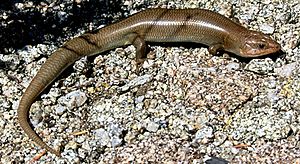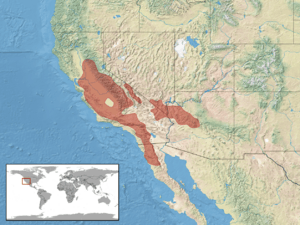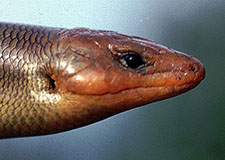Gilbert's skink facts for kids
Quick facts for kids Gilbert's skink |
|
|---|---|
 |
|
| Scientific classification | |
| Genus: |
Plestiodon
|
| Species: |
gilberti
|
 |
|
| Synonyms | |
|
|
Gilbert's skink, also known as Plestiodon gilberti, is a type of medium-sized lizard. It has a strong, heavy body. This skink belongs to the skink family, called Scincidae. Gilbert's skink lives only in the southwestern United States. It can grow to be about 7 to 12 centimeters (3 to 5 inches) long, including its tail.
Contents
About Gilbert's Skink
Gilbert's skink was first described in 1896 by a scientist named John Van Denburgh. He named the skink after his teacher, Dr. Charles H. Gilbert. Dr. Gilbert was a professor who studied animals at Stanford University.
Gilbert's skink is part of a group of skinks called the "skiltonianus group." This group includes the western skink, the San Lucan skink, and the four-lined Asiatic skink. Scientists are still studying this group. They use DNA analysis to learn more about how these skinks are related.
Types of Gilbert's Skink
There are five different types, or subspecies, of Gilbert's skink. These are like different versions of the same animal.
- Plestiodon gilberti arizonensis (Lowe & Shannon, 1954) – This is called the Arizona skink.
- Plestiodon gilberti gilberti (Van Denburgh, 1896) – This is the greater brown skink.
- Plestiodon gilberti placerensis (Rodgers, 1944) – This one is known as the northern brown skink.
- Plestiodon gilberti cancellosus (Rodgers and Fitch, 1947) – This is the variegated skink.
- Plestiodon gilberti rubricaudatus (Taylor, 1935) – This type is called the western red-tailed skink.
Sometimes, you might see a name in parentheses after a subspecies name. This means that the subspecies was first described under a different main group name. For example, P. g. placerensis is named after Placer County, California, where it lives.
Where Gilbert's Skink Lives
Gilbert's skink mostly lives in California. You can find it in the northern San Joaquin Valley. It also lives in the foothills of the Sierra Nevada mountains. These skinks are found from Butte County down to the Mexican border. They also live in northern Baja California.
You can also find them in the mountains of southern California. Some small groups live in the eastern desert, from Mono County to San Bernardino County. There are also separate groups in western Arizona and southern Nevada.
Skink Habitats
Gilbert's skink can live in many different places. They are found from sea level up to about 2,200 meters (7,200 feet) high. These lizards prefer open areas. They like places like grasslands, open chaparral areas, or open pine forests. They usually avoid very thick bushes or dense forests.
What Gilbert's Skink Looks Like
Gilbert's skink is a lizard with a strong body and small legs. Adult skinks are usually a solid color. They can be green, grey, olive, or brown.
Young skinks look different. They have light stripes on their sides and back. These stripes surround a wide black or brown stripe. This dark stripe stops near the base of their tail. Their tail is often a waxy-pink color. As the skinks grow older, their stripes fade away.
Skink Behavior
Gilbert's skink is a sturdy lizard. It is not often seen out in the open. It likes to search for food among fallen leaves and thick plants. Sometimes, it digs through loose soil. This skink is good at burrowing. It often makes its own home by digging under rocks or rotting logs.
Reproduction and Life Cycle
The time of year when Gilbert's skinks reproduce can change. It depends on where they live and the conditions each year. Scientists don't know a lot about their exact breeding times. However, it is probably similar to the Western skink.
Female skinks build nests in soft, damp soil. They dig several centimeters deep. They especially like to build nests under flat stones. A female skink usually lays between 3 and 9 eggs at a time.


